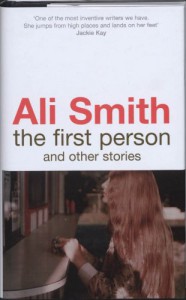Currently reading
Financial Intelligence: A Manager's Guide to Knowing What the Numbers Really Mean
The Cambridge Companion to Jane Austen
Hildegard of Bingen: A Spiritual Reader
The First Person and Other Stories
 Ali Smith's world is at times bleak and lonely, at times rich and full, but in all cases a different take on life than we usually see. Smith has garnered a strong following in her short career, and this new Anchor books edition of The First Person and Other Stories solidifies the fact that she is a voice we will continue to hear from. Whether this book will be the one recommended to new readers of her work is another question.Smith plays with the short story form, at times unsuccessfully. Her opening story, "True Short Story," is what the title says -- a true short story. The narrator overhears two men, possibly father and son, discussing literature. Their thinking drives the narrator to talk to her literary friend, battling cancer, to discuss if the short story is truly a slim nymph as described by the younger of the two men. But the story sounds more like a memoir than a short story, which is ironic since the story is a celebration of the short story.But when she succeeds Smith proves she is worth the patience. "The Child" features a foul-mouthed, talking baby who simply shows up in the narrator's shopping cart one day. Despite her resistance to what is perhaps things to come, she finds herself drawn into caring for the sexist, racist, angelic-looking child. But in the end she finds another way to solve her problem.While "The Child" features resolution, Smith is comfortable not finishing the story. Many of the selections show us the modern "slice-of-life" snippets, but they are not without future direction. Smith differs from many contemporary writers in that some of the stories have hope built in them as well. In "The Second Person" we watch a couple fight their way into separation, but in the end an accordion and its missing mate indicate a renewal of the relationship.The eponymous final story is a touching love story in which one of the characters works hard to convince herself that her new relationship is nothing special. Her lover is not discouraged."You're not the first person who ever made me feel like this, you know, I say.I'm the first person today, though, you say."The passage is indicative of Smith's thinking, a focus on living in the present. It also shows hers fondness for quoting her characters with "I say -- you say -- he said -- she said" phrases as opposed to direct quotes. At times it can be confusing on who is speaking, but Smith is likely intentional here. She also often leaves genders, especially in relationships, unspoken. How the reader interprets these stories may say as much about them as Smith.Overall we see Smith experimenting with the short story form, and like most experiments there are both failures and successes. But like most experiments, they are worth the effort.
Ali Smith's world is at times bleak and lonely, at times rich and full, but in all cases a different take on life than we usually see. Smith has garnered a strong following in her short career, and this new Anchor books edition of The First Person and Other Stories solidifies the fact that she is a voice we will continue to hear from. Whether this book will be the one recommended to new readers of her work is another question.Smith plays with the short story form, at times unsuccessfully. Her opening story, "True Short Story," is what the title says -- a true short story. The narrator overhears two men, possibly father and son, discussing literature. Their thinking drives the narrator to talk to her literary friend, battling cancer, to discuss if the short story is truly a slim nymph as described by the younger of the two men. But the story sounds more like a memoir than a short story, which is ironic since the story is a celebration of the short story.But when she succeeds Smith proves she is worth the patience. "The Child" features a foul-mouthed, talking baby who simply shows up in the narrator's shopping cart one day. Despite her resistance to what is perhaps things to come, she finds herself drawn into caring for the sexist, racist, angelic-looking child. But in the end she finds another way to solve her problem.While "The Child" features resolution, Smith is comfortable not finishing the story. Many of the selections show us the modern "slice-of-life" snippets, but they are not without future direction. Smith differs from many contemporary writers in that some of the stories have hope built in them as well. In "The Second Person" we watch a couple fight their way into separation, but in the end an accordion and its missing mate indicate a renewal of the relationship.The eponymous final story is a touching love story in which one of the characters works hard to convince herself that her new relationship is nothing special. Her lover is not discouraged."You're not the first person who ever made me feel like this, you know, I say.I'm the first person today, though, you say."The passage is indicative of Smith's thinking, a focus on living in the present. It also shows hers fondness for quoting her characters with "I say -- you say -- he said -- she said" phrases as opposed to direct quotes. At times it can be confusing on who is speaking, but Smith is likely intentional here. She also often leaves genders, especially in relationships, unspoken. How the reader interprets these stories may say as much about them as Smith.Overall we see Smith experimenting with the short story form, and like most experiments there are both failures and successes. But like most experiments, they are worth the effort.





